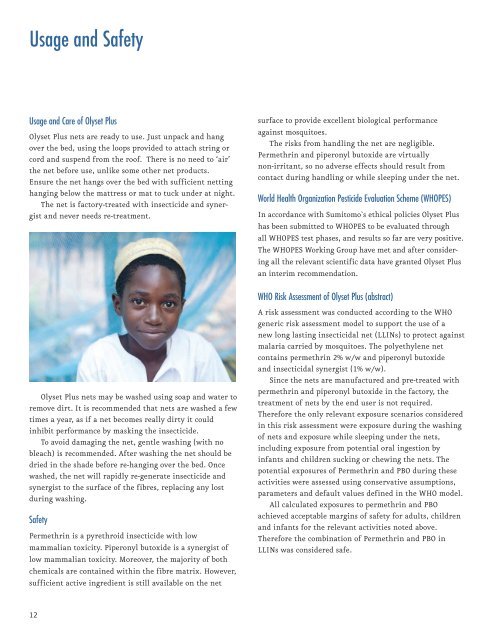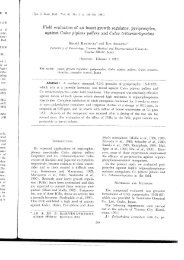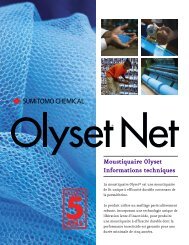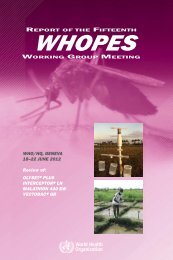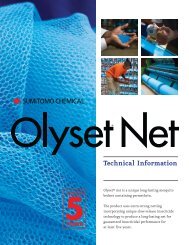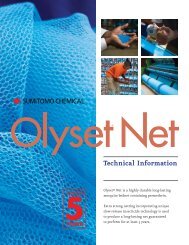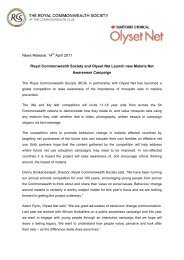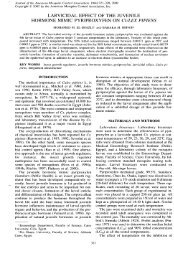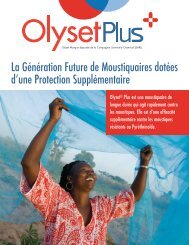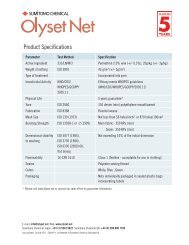Download PDF - Olyset Net
Download PDF - Olyset Net
Download PDF - Olyset Net
Create successful ePaper yourself
Turn your PDF publications into a flip-book with our unique Google optimized e-Paper software.
Usage and Safety<br />
Usage and Care of <strong>Olyset</strong> Plus<br />
<strong>Olyset</strong> Plus nets are ready to use. Just unpack and hang<br />
over the bed, using the loops provided to attach string or<br />
cord and suspend from the roof. There is no need to ‘air’<br />
the net before use, unlike some other net products.<br />
Ensure the net hangs over the bed with sufficient netting<br />
hanging below the mattress or mat to tuck under at night.<br />
The net is factory-treated with insecticide and synergist<br />
and never needs re-treatment.<br />
<strong>Olyset</strong> Plus nets may be washed using soap and water to<br />
remove dirt. It is recommended that nets are washed a few<br />
times a year, as if a net becomes really dirty it could<br />
inhibit performance by masking the insecticide.<br />
To avoid damaging the net, gentle washing (with no<br />
bleach) is recommended. After washing the net should be<br />
dried in the shade before re-hanging over the bed. Once<br />
washed, the net will rapidly re-generate insecticide and<br />
synergist to the surface of the fibres, replacing any lost<br />
during washing.<br />
Safety<br />
Permethrin is a pyrethroid insecticide with low<br />
mammalian toxicity. Piperonyl butoxide is a synergist of<br />
low mammalian toxicity. Moreover, the majority of both<br />
chemicals are contained within the fibre matrix. However,<br />
sufficient active ingredient is still available on the net<br />
surface to provide excellent biological performance<br />
against mosquitoes.<br />
The risks from handling the net are negligible.<br />
Permethrin and piperonyl butoxide are virtually<br />
non-irritant, so no adverse effects should result from<br />
contact during handling or while sleeping under the net.<br />
World Health Organization Pesticide Evaluation Scheme (WHOPES)<br />
In accordance with Sumitomo`s ethical policies <strong>Olyset</strong> Plus<br />
has been submitted to WHOPES to be evaluated through<br />
all WHOPES test phases, and results so far are very positive.<br />
The WHOPES Working Group have met and after considering<br />
all the relevant scientific data have granted <strong>Olyset</strong> Plus<br />
an interim recommendation.<br />
WHO Risk Assessment of <strong>Olyset</strong> Plus (abstract)<br />
A risk assessment was conducted according to the WHO<br />
generic risk assessment model to support the use of a<br />
new long lasting insecticidal net (LLINs) to protect against<br />
malaria carried by mosquitoes. The polyethylene net<br />
contains permethrin 2% w/w and piperonyl butoxide<br />
and insecticidal synergist (1% w/w).<br />
Since the nets are manufactured and pre-treated with<br />
permethrin and piperonyl butoxide in the factory, the<br />
treatment of nets by the end user is not required.<br />
Therefore the only relevant exposure scenarios considered<br />
in this risk assessment were exposure during the washing<br />
of nets and exposure while sleeping under the nets,<br />
including exposure from potential oral ingestion by<br />
infants and children sucking or chewing the nets. The<br />
potential exposures of Permethrin and PBO during these<br />
activities were assessed using conservative assumptions,<br />
parameters and default values defined in the WHO model.<br />
All calculated exposures to permethrin and PBO<br />
achieved acceptable margins of safety for adults, children<br />
and infants for the relevant activities noted above.<br />
Therefore the combination of Permethrin and PBO in<br />
LLINs was considered safe.<br />
12


